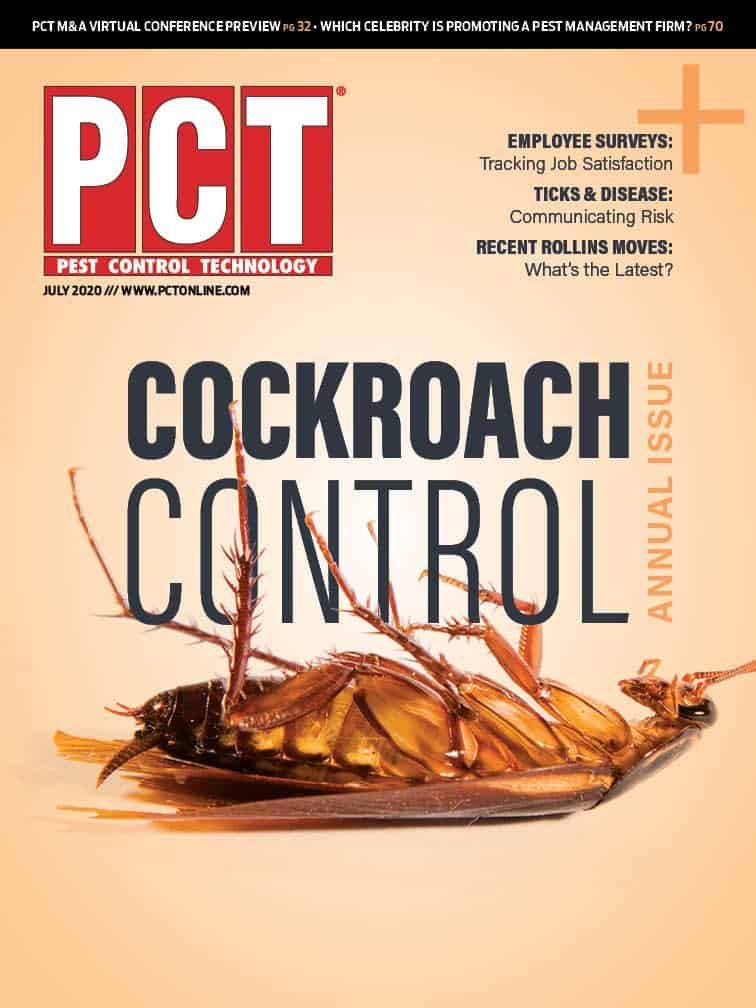
©Stoy Hedges
Crack and crevice application is a desirable pest management option. We believe that many pest control customers prefer crack and crevice treatment over general spraying or even void treatments. We know that facilities contracting for IPM programs are expecting to see the words “crack and crevice” as part of a proposal. In fact, those in the pest management industry use the term so often in describing what they do that we need to question if that, in fact, is what we are doing. Even further, we need to ask whether crack and crevice treatment is the best type of treatment for the pest and the site.
WHAT IS IT? A crack and crevice treatment is the application of a small amount of insecticide directly into cracks and crevices where insects hide or where they may enter. The German cockroach prefers to hide inside a crack only 3/16-inch (4.7 mm) wide.
The definition of crack and crevice treatment includes application of insecticide behind, between and under objects and into inaccessible small voids. Typical crack and crevice treatment sites are between cabinets and walls, behind countertop backsplashes, in hollow equipment legs or bases, behind kickplates, in drawer tracks, behind baseboards or moldings, between or under appliances or pieces of equipment, expansion joints, conduits, junction boxes and around plumbing openings into walls.
In comparison, a “spot application” is made to a limited area not to exceed 2 square feet. It is generally made to baseboards, around doorways and in other sites, and leaves insecticide on treated surfaces. If you’re treating surfaces, you are not doing crack and crevice.
GOAL OF C&C TREATMENT. Crack and crevice treatment is a precise application into tight places where insects are known to hide or travel. It delivers insecticide more directly to the insect instead of waiting for insects to walk across treated surfaces. Crack and crevice treatments are also used to flush insects out of their hiding places during inspections or so that they contact treated surfaces. Some pesticides can be used as a crack and crevice treatment to repel insects and keep them out of certain cracks and crevices.
EQUIPMENT NEEDED. Liquids, aerosols, dusts and gel baits can all be applied as crack and crevice treatments if application is done with a special injector tip that directs the product only into the desired space. Crack and crevice applications of liquids requires only a compressed air sprayer that can be inserted directly into the crack. Trying to use a pin stream or fan spray nozzle results in too much splash-back and too little penetration into the crack. Many RTU products come with a crack and crevice plastic injector straw.
PESTS CONTROLLED. Know your pest. Crack and crevice treatments are used against crawling pests that hide, lay their eggs or travel in cracks or tight spaces. Usually these are pests that hide during the day in out-of-the-way places and are active at night, such as cockroaches, silverfish, bed bugs and centipedes. German cockroaches spend more than 90 percent of their day hidden in dark, quiet crevices and voids.
ADVANTAGES. The reason that customers like the idea of crack and crevice is that it keeps insecticide out of the air and off of surfaces. Crack and crevice is a particularly desirable option when treating around children, as well as the ill, elderly or others who may have sensitivities to pesticides or airborne residues. Crack and crevice treatment helps to keep the insecticide confined, off of food and other surfaces, and out of the reach of children and pets.
The reason that PMPs like crack and crevice is because it’s a targeted application that, when used correctly, places the product where the pests are hiding and reduces insecticide exposure to non- targets. Since crack and crevice applications are targeted, you can use less insecticide. Applications last longer since the product is protected from air currents, light, heat and moisture.
Some products allow only crack and crevice applications in food areas since an insecticide deposit on an exposed surface may be in violation of federal law.
DISADVANTAGES. Crack and crevice is not the best choice for all pests or all situations. If the pest you’re trying to control isn’t known to frequent cracks and crevices, you’re wasting your time. For example, trying to control a drain fly infestation by treating cracks and crevices in a bathroom will have little effect since the larvae live inside drains and pipes and the adults fly, resting on walls or ceilings. Flying insects, spiders, crickets and fleas are some of the pets that are generally not good candidates for crack and crevice applications. A successful treatment requires some knowledge of the target pest, its habits and its hiding places.
Crack and crevice application can be more time-consuming than other methods, involving applications into more sites. Insecticide can splash out of the crevice onto surfaces if you are using high pressure or are not using an injector tip.
The authors are well-known industry consultants and co-owners of Pinto & Associates.

Explore the July 2020 Issue
Check out more from this issue and find your next story to read.
Latest from Pest Control Technology
- SiteOne Hosts 2024 Women in Green Industry Conference
- Veseris Celebrates Grand Reopening of the Miami ProCenter
- Rollins' 2024 Second Quarters Revenues up 8.7 Percent YOY
- Fleetio Go Fleet Maintenance App Now Available in Spanish
- German Cockroach Control Mythbusting
- Total Pest Control Acquires Target Pest Control
- NPMA Workforce Development Shares Hiring Updates
- Certus Acquires Jarrod's Pest Control





